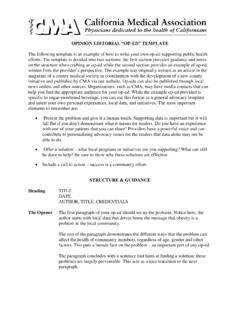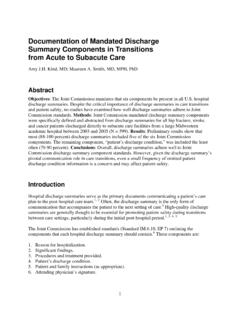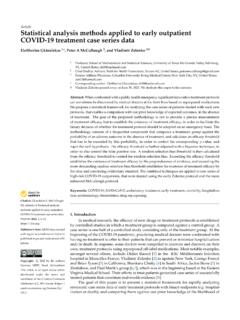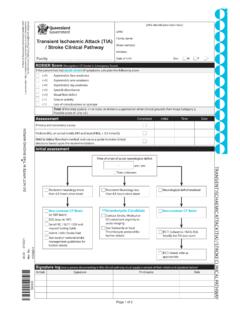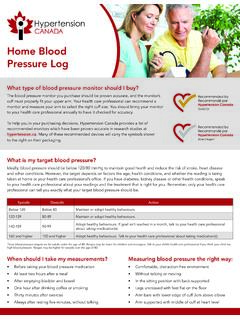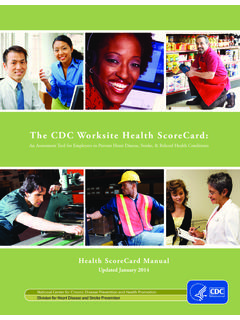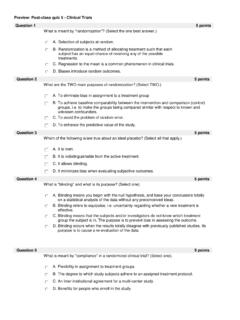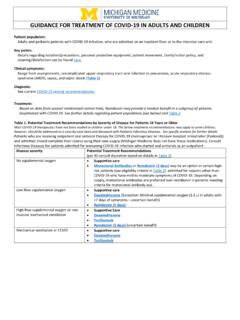Transcription of Clinical Protocol for the Prevention and Treatment of ...
1 Clinical Protocol for the Prevention and Treatment of Diabetes in Adults Page 2 of 21 Acknowledgements We would like to extend special thanks to the following individuals for their assistance in the development and review of this document: Intrepid Ascent Sokkim Lim, PharmD John Weir, MS Keira Armstrong, MPH Wendy Jameson, MPP, MPH Joshua May, BA Mark Elson, PhD California Department of Public Health Chronic Disease Control Branch Jessica N ez de Ybarra, MD, MPH, FACPM Alexandria Simpson, BS Catrina Taylor, PhD, MSPH Lauren Gernon, MPH This publication was produced with funding from Centers for Disease Control and Prevention (CDC) Grant Numbers DP005499 and DP004795 through the California Department of Public Health. Its contents are solely the responsibility of the authors and do not necessarily represent the official views of the CDC or the Department of Health and Human Services.
2 The content included in this report may be reproduced with the following citation: Lim S, Weir J, Armstrong K, Jameson W, May J, Elson M (2018). Clinical Protocol for the Prevention and Treatment of Diabetes in Adults. Commissioned by the Chronic Disease Control Branch, California Department of Public Health, Sacramento, CA May 2018 Page 3 of 21 Table of Contents Introduction .. 4 Purpose .. 4 Classification of Diabetes .. 5 Di agnostic Criteria .. 6 Criteria for Screening for Diabetes and Prediabetes .. 6 Data Extraction from Electronic Health Records (EHRs) to Identify Patients with Prediabetes .. 8 Outreach/Pre-Visit Planning/Panel Management (Recall) .. 9 Lifestyle Management .. 9 Nutritional Therapy .. 10 Physical Activity and Exercise .. 10 Tobacco and Smoking Cessation .. 10 Assessing Glycemic Control .. 11 Managing Hypoglycemia .. 13 Pharmacological Therapy for Patients with Type 1 Diabetes.
3 13 Pharmacological Therapy for Patients with Type 2 Diabetes .. 14 Conclusion .. 14 Appendix I: Diabetes Risk Test .. 16 Appendix II: Medical Nutrition Therapy (MNT) Recommendations .. 17 Appendix III: ADA Antihyperglycemic Therapy Recommendations for Adults with Type 2 Diabetes .. 20 Appendix IV: ADA Combination Injectable Therapy Recommendations for Patients with Type 2 Diabetes .. 21 Page 4 of 21 Introduction Currently, an estimated million Americans continue to live with diabetes and more than 84 million live with prediabetes. In 2015, diabetes was the seventh leading cause of death in the United States and the leading cause for kidney failure, lower-limb amputations, and adult-onset Heart disease and stroke are two to four times more likely for individuals with diabetes. With diabetes being a public health priority, the Centers for Disease Control and Prevention (CDC), public health professionals, state health departments and communities are working collaboratively to achieve optimal health outcomes for patients with diabetes.
4 This will require an organized, systematic approach to providing high-quality, patient-centered care. Purpose To present practice guidelines and recommendations for primary health care providers serving adults diagnosed with diabetes or are at-risk of developing diabetes. This document provides population management tools and approaches to proactively monitor and manage diabetes, which includes evidence-based Treatment protocols and approaches using Clinical practice data to drive improvement. 1 Centers for Disease Control and Prevention . National Diabetes Statistics Report: Estimates of Diabetes and Its Burden in the United States, 2017. Atlanta, GA: Department of Health and Human Services; 2017. Page 5 of 21 Classification of Diabetes Diabetes is a disease that affects how the body produces or uses insulin.
5 As a result, patients with diabetes are unable to process energy from food properly which leads to elevated levels of glucose. Prediabetes is asymptomatic and occurs when blood glucose levels are higher than normal but not high enough to be diagnosed as , 3 Among the population diagnosed with diabetes, there are three types of diabetes (Table 1).4 TABLE 1. Classification of Diabetes Type Classification Type 1 Diabetes Due to autoimmune -cell destruction, usually leading to absolute insulin deficiency Type 2 Diabetes Due to a progressive loss of -cell insulin secretion frequently associated with insulin resistance Gestational Diabetes Mellitus (GDM) Diagnosed in the second or third trimester of pregnancy that was not clearly overt diabetes prior to gestation Classification is important for determining therapy; however, it may be difficult at the time of diagnosis to determine an individual s type of diabetes.
6 Contrary to traditional paradigms, both diseases occur in all age groups. As shown in Table 2, the common symptoms for type 1 and type 2 diabetes are similar, but may vary greatly between individuals. In some cases, individuals may not have any symptoms or symptoms may be so mild that they go unnoticed. TABLE 2. Common Symptoms of Diabetes Prediabetes No symptoms 2 Expert Committee on the Diagnosis and Classification of Diabetes Mellitus. Report of the Expert Committee on the Diagnosis and Classification of Diabetes Mellitus. Diabetes Care 1997; 20:1183 1197 3 Genuth S, Alberti KG, Bennett P, et al.; Expert Committee on the Diagnosis and Classification of Diabetes Mellitus.
7 Follow-up report on the diagnosis of diabetes mellitus. Diabetes Care 2003;26: 3160 3167 4 American Diabetes Association. Diagnosis and classification of diabetes mellitus. Diabetes Care 2014;37(Suppl. 1):S81 S90 Page 6 of 21 Diagnostic Criteria Diabetes and prediabetes may be diagnosed using the plasma glucose criteria which includes fasting plasma glucose (FPG), 2-h plasma glucose (2-h PG) during a 75-g oral glucose tolerance test (OGTT), random plasma glucose (RPG), or glycosylated hemoglobin (A1C) screening test (Table 3).5 TABLE 3. Criteria for Diagnosis of Diabetes and Prediabetes Prediabetes Diabetes FPG Blood sample taken after overnight fasting 140 199 mg/dL ( mmol/L) 200 mg/dL ( mmol/L) 2-h PG Blood samples taken periodically for two hours after overnight fasting and drinking a glucose-containing liquid 100 125 mg/dL ( mmol/L) 126 mg/dL ( mmol/L) A1C Measures average blood glucose control for the past 2 to 3 months.
8 This test is more convenient because no fasting is required (39 mmol/mol - <48 mmol/mol) (48 mmol/mol) RPG Blood sample taken at a random time, regardless of when last meal was eaten ---- 200 mg/dL ( mmol/L) Unless there is a clear Clinical diagnosis, a second test is necessary for confirmation. It is recommended that the same test be repeated or a different test be performed immediately using a separate blood sample. If test results are near the margins of the diagnostic threshold, the patient should continue to be monitored and a test should be repeated in 3 6 Criteria for Screening for Diabetes and Prediabetes According to CDC and the American Diabetes Association (ADA) guidelines, patients should be screened for the following criteria: Physical inactivity First-degree relative with diabetes (sibling or parent) High-risk race/ethnicity Women who delivered a baby >9 lb or were diagnosed with gestational diabetes mellitus (GDM) HDL cholesterol (HDL-C) 250 mg/dL Hypertension ( 140/90 mm Hg or on therapy) A1C , impaired glucose tolerance (IGT), or impaired fasting glucose (IFG) on previous testing Conditions associated with insulin resistance.
9 Severe obesity, Acanthosis Nigricans, Polycystic Ovarian Syndrome (PCOS) History of cardiovascular disease (CVD) 5 International Expert Committee. International Expert Committee report on the role of the A1C assay in the diagnosis of diabetes. Diabetes Care 2009;32:1327 1334 6 American Diabetes Association. 2. Classification and diagnosis of diabetes: Standards of Medical Care in Diabetes 2018. Diabetes Care 2018;41(Suppl. 1):S13 S27 Page 7 of 21 FIGURE 1. Point-of -Care Possible Prediabetes and Diabetes Identification Screening should be performed on adults of any age who are overweight or obese, and who have one or more of the above diabetes risk factors. Assessing an individual s history of CVD is particularly important, as it is the major cause of morbidity and mortality for individuals with diabetes. Common conditions that coexist with type 2 diabetes ( , hypertension and dyslipidemia) are clear risk factors for CVD.
10 Numerous studies have shown the efficacy of controlling individual CVD risk factors in Page 8 of 21 preventing or slowing CVD in people with diabetes. Large benefits are seen when multiple risk factors are addressed , 8 If a screening test is normal, it should be repeated at least every three years. The flow chart above outlines a sample workflow to assist providers in identifying patients for possible prediabetes (Figure 1).9 Data Extraction from Electronic Health Records (EHRs) to Identify Patients with Prediabetes While a singular national standard algorithm for extracting data to identify patients with prediabetes using EHRs does not exist, there are several algorithms available as references. The key to a successful initiative is to begin small and to scale the program as resources allow. Extracting data from the EHR may result in an overwhelming amount of information; prioritizing and narrowing the scope of the extraction and/or subsequent outreach efforts can help mitigate the impact on the organization.
